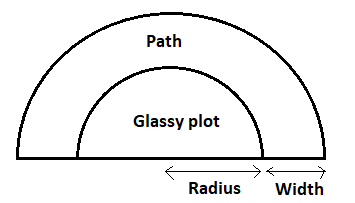
A path of width 3.5m runs around a semi-circular grassy plot whose perimeter is 72m. Find the area of the path.
Answer
524.7k+ views
Hint: Let us first draw the figure of plot and the path. And the find the area of semicircle included path and area of semicircle excluded path (plot only).
Complete step-by-step answer:

As we know that the perimeter of the semicircle is calculated as
So, let the radius of the grassy plot be r metres.
And it is given that the perimeter of the grassy plot is 72m.
Now taking LCM on the LHS of the above equation. We get,
Now multiplying both sides of the above equation by
Now as we can see from the above figure that the radius of outer semicircle (plot included with path) is the sum of radius of inner semicircle and width of the path.
So, let the radius of outer semicircle be R metres.
So, R = r + width of the plot = 14 m + 3.5 m = 17.5 metres
Now we are asked to find the area of the path.
And as we can see from the above figure that the area of the path is the area of the inner semicircle (glassy plot) subtracted from the area of the outer semicircle (glassy plot with path included).
As we know that the area of the semicircle with radius r is
So, the area of the outer semicircle (glassy plot with path included) will be equal to
And the area of the inner semicircle (glassy plot) will be equal to
So, the area of the path will be = area of outer semicircle – area of the inner semicircle =
Hence, the area of the path will be
Note:- Whenever we come up with this type of problem then first, we have to draw the figure. And then we had to calculate the radius of the inner semicircle by comparing the given perimeter with
Complete step-by-step answer:

As we know that the perimeter of the semicircle is calculated as
So, let the radius of the grassy plot be r metres.
And it is given that the perimeter of the grassy plot is 72m.
Now taking LCM on the LHS of the above equation. We get,
Now multiplying both sides of the above equation by
Now as we can see from the above figure that the radius of outer semicircle (plot included with path) is the sum of radius of inner semicircle and width of the path.
So, let the radius of outer semicircle be R metres.
So, R = r + width of the plot = 14 m + 3.5 m = 17.5 metres
Now we are asked to find the area of the path.
And as we can see from the above figure that the area of the path is the area of the inner semicircle (glassy plot) subtracted from the area of the outer semicircle (glassy plot with path included).
As we know that the area of the semicircle with radius r is
So, the area of the outer semicircle (glassy plot with path included) will be equal to
And the area of the inner semicircle (glassy plot) will be equal to
So, the area of the path will be = area of outer semicircle – area of the inner semicircle =
Hence, the area of the path will be
Note:- Whenever we come up with this type of problem then first, we have to draw the figure. And then we had to calculate the radius of the inner semicircle by comparing the given perimeter with
Recently Updated Pages
Master Class 10 General Knowledge: Engaging Questions & Answers for Success

Master Class 10 Computer Science: Engaging Questions & Answers for Success

Master Class 10 Science: Engaging Questions & Answers for Success

Master Class 10 Social Science: Engaging Questions & Answers for Success

Master Class 10 Maths: Engaging Questions & Answers for Success

Master Class 10 English: Engaging Questions & Answers for Success

Trending doubts
A boat goes 24 km upstream and 28 km downstream in class 10 maths CBSE

Why is there a time difference of about 5 hours between class 10 social science CBSE

The British separated Burma Myanmar from India in 1935 class 10 social science CBSE

The Equation xxx + 2 is Satisfied when x is Equal to Class 10 Maths

Chandigarh is the capital of A Punjab B Haryana C Punjab class 10 social science CBSE

Change the following sentences into negative and interrogative class 10 english CBSE




